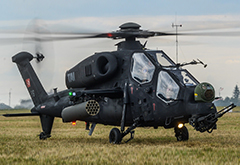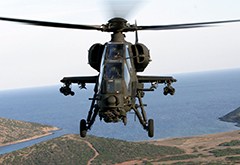The Agusta A129 Mangusta is an attack helicopter originally designed and produced by Italian company Agusta. It is the first attack helicopter to be designed and produced wholly in Europe. It has continued to be developed by AgustaWestland, the successor company to Agusta. The A129 has undergone several combat deployments since entering service with the Italian Army in the 1990s.
A derivative of the A129, the TAI/AgustaWestland T129 ATAK, has been developed by Turkish Aerospace Industries in cooperation with AgustaWestland for the Turkish Army and potential customers.
 The A129 can be used in the anti-armour, armed reconnaissance, ground attack, escort, fire support and anti-aircraft roles. For the anti-ground mission the helicopter can employ various armaments, such as up to eight Hellfire missiles. In the air-to-air role, the FIM-92 Stinger missile was certified for use in 2003. The A129 can also be equipped with 81 mm or 70 mm (2.75 in) unguided rockets; a M197 three-barrel 20 mm cannon is also installed onto a nose-mounted Oto Melara TM-197B turret. By 2014, the Spike-ER, a fourth-generation anti-tank missile, had been added to the A129's arsenal.
The A129 can be used in the anti-armour, armed reconnaissance, ground attack, escort, fire support and anti-aircraft roles. For the anti-ground mission the helicopter can employ various armaments, such as up to eight Hellfire missiles. In the air-to-air role, the FIM-92 Stinger missile was certified for use in 2003. The A129 can also be equipped with 81 mm or 70 mm (2.75 in) unguided rockets; a M197 three-barrel 20 mm cannon is also installed onto a nose-mounted Oto Melara TM-197B turret. By 2014, the Spike-ER, a fourth-generation anti-tank missile, had been added to the A129's arsenal.
A derivative of the A129, the TAI/AgustaWestland T129 ATAK, has been developed by Turkish Aerospace Industries in cooperation with AgustaWestland for the Turkish Army and potential customers.
The A129 Mangusta is the first European attack helicopter; as such it has several original aspects to its design, such as being the first helicopter to make use of a fully computerised integrated management system to reduce crew workload. It was decided that much of the helicopter's functionality was to be automated; as such, parts of the flight and armament systems are monitored and directly controlled by onboard computers. The A129 shares considerable design similarities to Agusta's earlier A109 utility helicopter; the rear section of the A129 was derived from the A109 and incorporated to an entirely new forward section. The A129's fuselage is highly angular and armoured for ballistic protection; the composite rotor blades are also able to withstand hits from 23mm cannon fire. The two man crew, comprising a pilot and gunner, sit in a conventional tandem cockpit.
 The A129 can be used in the anti-armour, armed reconnaissance, ground attack, escort, fire support and anti-aircraft roles. For the anti-ground mission the helicopter can employ various armaments, such as up to eight Hellfire missiles. In the air-to-air role, the FIM-92 Stinger missile was certified for use in 2003. The A129 can also be equipped with 81 mm or 70 mm (2.75 in) unguided rockets; a M197 three-barrel 20 mm cannon is also installed onto a nose-mounted Oto Melara TM-197B turret. By 2014, the Spike-ER, a fourth-generation anti-tank missile, had been added to the A129's arsenal.
The A129 can be used in the anti-armour, armed reconnaissance, ground attack, escort, fire support and anti-aircraft roles. For the anti-ground mission the helicopter can employ various armaments, such as up to eight Hellfire missiles. In the air-to-air role, the FIM-92 Stinger missile was certified for use in 2003. The A129 can also be equipped with 81 mm or 70 mm (2.75 in) unguided rockets; a M197 three-barrel 20 mm cannon is also installed onto a nose-mounted Oto Melara TM-197B turret. By 2014, the Spike-ER, a fourth-generation anti-tank missile, had been added to the A129's arsenal.Power is provided by a pair of Rolls-Royce Gem 2-1004D turboshaft engines, the engines have been designed to incorporate infrared heat signature reduction measures. One of the key protective measures incorporated onto the A129 include the electronic warfare and SIAP (Single Integrated Air Picture) self-protection suite. Elements of the mission interface systems and the onboard software integrated onto later aircraft were produced by Selex Galileo.
The A129 is equipped with infrared night vision systems and is capable of operating at day or night in all-weather conditions. Laser systems are fitted onto newer aircraft for range-finding and target designation purposes, the A129 can laser-designate targets for other friendly aircraft to attack. On the AW129D, Rafael Advanced Defense Systems's Toplite III sight is used as the primary targeting system; it is able to act as a FLIR and has both manual and automatic target tracking modes, Toplite also provides a greater detection and identification range than the 1970s era HeliTOW sensor it replaced. In 1998, Israel Aircraft Industries (IAI) formally partnered with Agusta to offer various avionics and weapons upgrades to potential A129 operators; various IAI technologies have since been proposed and implemented on Italian A129s. More details
